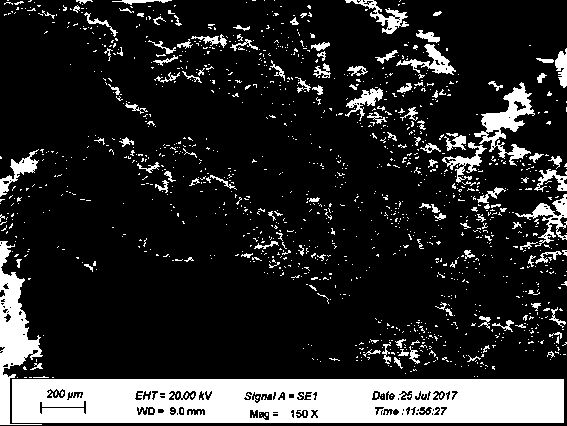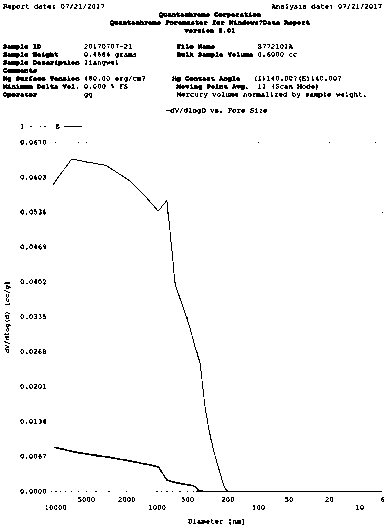3D printing molding material
A molding material, 3D printing technology, applied in applications, household appliances, additive processing, etc., can solve the problems of high density of molded products, low sintering shrinkage, difficult to prepare heat insulation, etc., and achieve good shape retention and low bulk density. , Improve the effect of material printing and forming performance
- Summary
- Abstract
- Description
- Claims
- Application Information
AI Technical Summary
Problems solved by technology
Method used
Image
Examples
Embodiment 1
[0024] A molding material for 3D printing. In parts by weight, 400 parts of 4 μm alumina powder, 200 parts of 1.2 μm alumina powder, and 30 parts of 0.6 μm alumina powder are respectively mixed with yellow dextrin with a mass fraction of 5%. The ethanol solution (the addition of the ethanol solution of yellow dextrin is 10% of the weight of the alumina powder) is ball milled and mixed and freeze-dried to obtain three kinds of modified alumina powders, wherein the freeze-drying method is: The mixture obtained after ball mill mixing is frozen at -10 ~ -30°C, and then dried in a vacuum drying oven at -10°C ~ -30°C and a vacuum of less than 100Pa for 24 hours to obtain modified alumina powder. The material-to-ball ratio (the ratio of raw materials to grinding balls) in the ball mill tank is 1:3;
[0025] Then the obtained three modified alumina powders were mixed and 150 parts of yellow dextrin powder were added, and then the mixed material was added to a ball mill tank with a rot...
Embodiment 2
[0028] A molding material for 3D printing. In parts by weight, 600 parts of 4 μm alumina powder, 300 parts of 1.2 μm alumina powder, and 70 parts of 0.6 μm alumina powder are mixed with yellow dextrin with a mass fraction of 10% respectively. The ethanol solution of yellow dextrin (the addition amount of the ethanol solution of yellow dextrin is 5% of the weight of alumina powder) is ball-milled and mixed and freeze-dried to obtain three kinds of modified alumina powders, wherein the freeze-drying method is the same as implementing Example 1, the material-ball ratio (ratio of raw material to grinding ball) in the ball mill jar is 1:3;
[0029] Then the obtained three modified alumina powders were mixed and 250 parts of yellow dextrin powder were added, and then the mixed material was added to a ball mill tank with a rotating speed of 600 rpm for 3 hours to obtain graded modified alumina powder and yellow paste Mixture of refined powder;
[0030] When the mixture of graded mod...
Embodiment 3
[0032] A molding material for 3D printing. In parts by weight, 500 parts of 4 μm alumina powder, 250 parts of 1.2 μm alumina powder, and 50 parts of 0.6 μm alumina powder are mixed with yellow dextrin with a mass fraction of 15% respectively. The ethanol solution (the addition of the ethanol solution of yellow dextrin is 8% of the weight of alumina powder) is ball milled and mixed and freeze-dried to obtain three kinds of modified alumina powders, wherein the method of freeze-drying is the same as that of implementing Example 1, the material-ball ratio (ratio of raw material to grinding ball) in the ball mill jar is 1:3;
[0033] Then the obtained three kinds of modified alumina powders were mixed and 200 parts of yellow dextrin powders were added, and then the mixed material was added into a ball mill tank with a rotating speed of 550 rpm for 2.5 hours to obtain graded modified alumina powders and yellow dextrin powders. Mixture of dextrin powder;
[0034] When the mixture o...
PUM
| Property | Measurement | Unit |
|---|---|---|
| strength | aaaaa | aaaaa |
| density | aaaaa | aaaaa |
| pore size | aaaaa | aaaaa |
Abstract
Description
Claims
Application Information
 Login to View More
Login to View More - R&D
- Intellectual Property
- Life Sciences
- Materials
- Tech Scout
- Unparalleled Data Quality
- Higher Quality Content
- 60% Fewer Hallucinations
Browse by: Latest US Patents, China's latest patents, Technical Efficacy Thesaurus, Application Domain, Technology Topic, Popular Technical Reports.
© 2025 PatSnap. All rights reserved.Legal|Privacy policy|Modern Slavery Act Transparency Statement|Sitemap|About US| Contact US: help@patsnap.com



